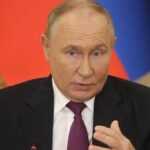Earlier this week, Vladimir Putin declared an end to the deal allowing Ukraine to export its grain to the world. This threatened to send prices surging, with a potentially devastating impact on world hunger. But his bluff was called. Turkey, Ukraine and the UN held talks and continued a deal without Russia – and three days later, Putin returned to the agreement. Why? And what does this tell us about Russian vulnerabilities?
The trigger for Putin pulling out was a drone strike on Russian ships near Sevastopol last Saturday. This was devastating for Moscow: until recently, Ukraine simply didn’t have such military capabilities. Now, suddenly, it does. Volodymyr Zelensky did not claim responsibility but local reports said the drone attack was led by Vasyl Malyuk, the head of Ukraine’s secret service. Putin’s navy looks like a sitting duck, with more strikes inevitable. As one Ukrainian analyst put it: ‘The idea of attacking the enemy’s fleet in a protected harbour is not new – it happened in Pearl Harbor. But a remote, unmanned attack is new.’
A Russian foreign ministry official wrote on Telegram that ‘the grain deal was thwarted by Zelensky’s terrorists, led by British specialists. They need more deaths. The Kyiv regime rests on this hellish throne: money, weapons, death’. Britain’s ambassador in Moscow, Deborah Bronnert, was summoned to Russia’s foreign ministry to hear Putin’s ‘strong protest’ even though no evidence of UK support was presented.
The drone strikes fitted a pattern of Russian naval vulnerability. The first was the sinking of its flagship Moskva by Ukrainian-made Neptune missiles. Then Russia lost Snake Island, an outpost Putin had planned to use as a launchpad for attacks on Odesa – which, if it fell, would give Russia control of the Black Sea. Now, Russia’s Black Sea fleet lives with the daily fear of drone attack.
At first, the purpose of Russia’s withdrawal from the grain agreement was to achieve further support from the West in the export of Russian agricultural products (not yet subject to sanctions). When this failed, Putin tried to use a grain deal to cover his fleet in Crimea, asking Ukraine to give ‘guarantees’ not to use the grain shipping corridor for military purposes (i.e. not to shell his Black Sea fleet). But logistically, there is no link between the two.
The grain deal is a rare diplomatic success. Ukraine supplies 10 per cent of the world’s grain and millions of tons of food had been going to waste since the invasion began in February. Russia, ultimately, could not afford to lose even more global support by being blamed for exacerbating world hunger. So the Kremlin ended up at a dead end – with Turkey prepared to become hostile and lend military support to get the grain moving again, perhaps joining forces with the US to escort grain shipments from Odesa through the Black Sea.
It was Turkish President Recep Tayyip Erdogan who talked Putin down. The UN grain corridor is a marker of his prestige and authority in Turkey (Erdogan faces elections next year). To soften criticisms from within his own country, Putin said Russia had decided to return to the grain agreement after receiving ‘guarantees’ from Ukraine not to use the corridor for military purposes. Ukraine’s officials denied the existence of new obligations that would go beyond those already outlined in July’s grain agreement.
All told, the episode underlines Russia’s naval vulnerability to Ukraine’s improving capabilities – and Turkey’s willingness to act robustly to protect the grain. The vast majority of Ukrainians believe they can win this war. This week helped show why.
Source : Spectator















